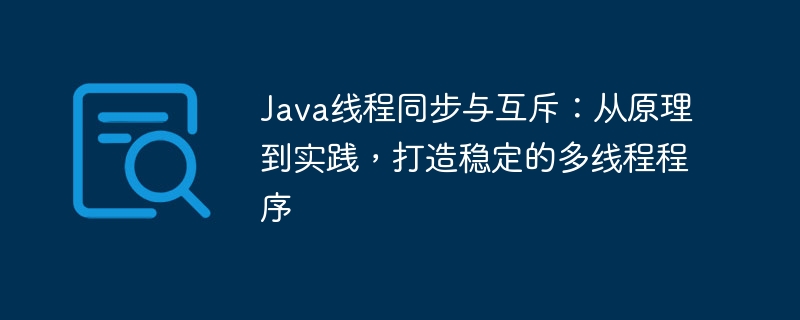
ThreadOverview of Synchronization and Mutual Exclusion
In multi-threaded programming, Java thread synchronization and mutual exclusion are crucial concepts. By understanding its principles and practical skills, it can help programmers build stable and reliable multi-threaded programs. In this article, PHP editor Strawberry will provide you with an in-depth analysis of Java thread synchronization and mutual exclusion, and create a more efficient multi-threaded programming experience for you.
Thread synchronization and mutual exclusion implementation methods
Java provides multiple ways to achieve thread synchronization and mutual exclusion, including:
-
Lock mechanism: Lock is a synchronization primitive that allows threads to access shared resources exclusively. Locks can be object locks or class locks. Object locks protect data in object instances, and class locks protect static data in classes.
-
Synchronized methods and synchronized blocks: Synchronized methods and synchronized blocks allow threads to have exclusive access to shared resources. A synchronized method is a method modified with the synchronized keyword, and a synchronized block is a code block modified with the synchronized keyword.
-
Atomic variables: Atomic variables are thread-safe basic data types, which ensure that read and write operations on variables are atomic, that is, uninterruptible.
Application scenarios of thread synchronization and mutual exclusion
Thread synchronization and mutual exclusion have a wide range of application scenarios in multi-threaded programming, including:
-
Shared resource access control: Prevent multiple threads from accessing shared resources at the same time to avoid data inconsistency and program crashes.
-
Critical section protection: Protect the critical section (that is, the code segment that accesses shared resources) from being accessed by multiple threads at the same time to avoid data contention and destruction.
-
Deadlock prevention: Avoid multiple threads waiting indefinitely while waiting for each other to release the lock, resulting in deadlock.
-
Thread-safe class design: Design thread-safe classes to ensure that instances of the class can be safely accessed by multiple threads in a multi-threaded environment.
Best practices for thread synchronization and mutual exclusion
When using thread synchronization and mutual exclusion, you need to pay attention to the following best practices:
-
Minimize the use of locks: Use locks only when necessary. Excessive use of locks may cause performance degradation.
-
Use appropriate lock granularity: Choosing an appropriate lock granularity can not only ensure concurrency, but also avoid unnecessary lock competition.
-
Avoid deadlock: Carefully consider the order of lock acquisition to avoid loop waiting, which may lead to deadlock.
-
Use thread-safe classes: Try to use thread-safe classes to avoid implementing thread synchronization yourself.
Conclusion
Thread synchronization and mutual exclusion are the basis of multi-threaded programming. Mastering these concepts and implementation methods is crucial to building stable and reliable multi-threaded programs. By properly using thread synchronization and mutual exclusion mechanisms, problems such as data inconsistency, program crashes, and deadlocks can be effectively prevented, ensuring the correctness and reliability of multi-threaded programs.
The above is the detailed content of Java thread synchronization and mutual exclusion: from principle to practice, creating stable multi-threaded programs. For more information, please follow other related articles on the PHP Chinese website!


